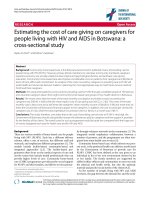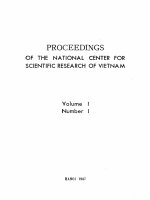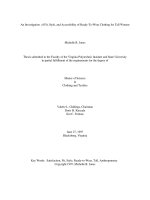Investigation of applying wild Bacillus species for sand stiffening
Bạn đang xem bản rút gọn của tài liệu. Xem và tải ngay bản đầy đủ của tài liệu tại đây (742.25 KB, 7 trang )
��������������������������������������������������������������������������������������������������������������������������������������������������������������������������������������������������������������������������������������������������������������������������������������������������������������������������������������������������������������������������������������������������������������������������������������������������������������������������������������������������������������������������������������������������������������������������������������������������������������������������������������������������������������������������������������������������������������������������������������������������������������������������������������������������������������������������������������������������������������������������������������������������������������������������������������������������������������������������������������������������������������������������������������������������������������������������������������������������������������������������������������������������������������������������������������������������������������������������������������������������������������������������������������������������������������������������������������������������������������������������������������������������������������������������������������������������������������������������������������������������������������������������������������������������������������������������������������������������������������������������������������������������������������������������������������������������������������������������������������������������������������������������������������������������������������������������������������������������������������������������������������������������������������������������������������������������������������������������������������������������������������������������������������������������������������������������������������������������������������������������������������������������������������������������������������������������������������������������������������������������������������������������������������������������������������������������������������������������������������������������������������������������������������������������������������������������������������������������������������������������������������������������������������������������������������������������������������������������������������������������������������������������������������������������������������������������������������������������������������������������������������������������������������������������������������������������������������������������������������������������������������������������������������������������������������������������������������������������������������������������������������������������������������������������������������������������������������������������������������������������������������������������������������������������������������������������������������������������������������������������������������������������������������������������������������������������������������������������������������������������������������������������������������������������������������������������������������������������������������������������������������������������������������������������������������������������������������������������������������������������������������������������������������������������������������������������������������������������������������������������������������������������������������������������������������������������������������������������������������������������������������������������������������������������������������������������������������������������������������������������������������������������������������������������������������������������������������������������������������������������������������������������������������������������������������������������������������������������������������������������������������������������������������������������������������������������������������������������������������������������������������������������������������������������������������������������������������������������������������������������������������������������������������������������������������������������������������������������������������������������������������������������������������������������������������������������������������������������������������������������������������������������������������������������������������������������������������������������������������������������������������������������������������������������������������������������������������������������������������������������������������������������������������������������������������������������������������������������������������������������������������������������������������������������������������������������������������������������������������������������������������������������������������������������������������������������������������������������������������������������������������������������������������������������������������������������������������������������������������������������������������������������������������������������������������������������������������������������������������������������������������������������������������������������������������������������������������������������������������������������������������������������������������������������������������������������������������������������������������������������������������������������������������������������������������������������������������������������������������������������������������������������������������������������������������������������������������������������������������������������������������������������������������������������������������������������������������������������������������������������������������������������������������������������������������������������������������������������������������������������������������������������������������������������������������������������������������������������������������������������������������������������������������������������������������������������������������������������������������������������������������������������������������������������������������������������������������������������������������������������������������������������������������������������������������������������������������������������������������������������������������������������������������������������������������������������������������������������������������������������������������������������������������������������������������������������������������������������������������������������������������������������������������������������������������������������������������������������������������������������������������������������������������������������������������������������������������������������������������������������������������������������������������������������������������������������������������������������������������������������������������������������������������������������������������������������������������������������������������������������������������������������������������������������������������������������������������������������������������������������������������������������������������������������������������������������������������������������������������������������������������������������������������������������������������������������������������������������������������������������������������������������������������������������������������������������������������������������������������������������������������������������������������������������������������������������������������������������������������������������������������������������������������������������������������������������������������������������������������������������������������������������������������������������������������������������������������������������������������������������������������������������������
0.1 mm sand samples of B. megaterium species. The consolidation was obtained better in 14-day
and 28-day samples, except 0.1 mm sand samples. This can be explained the low porosity was
good for consolidation at first. However, when the bacteria grew, the process of calcite
precipitation in the surface and around the bacterial cell could be continued and particle becomes
larger, the low porosity of sands was the limitation factor for the calcifying process.
Figure 3. Tensile strength of 14-day and 28-day samples of B. subtilis (S) and B. megaterium (M).
The 14-day and 28-day samples were tested the impact strength (Figure 3). The testing
shows that continuance of the bacterial growth and cultivation and the expansion of calcite
precipitation can cause the stiffening of sand. In all of the same sand size samples, the tensile
strength of B. megaterium is higher than of B. subtilis. These results demonstrated that B.
megaterium stiffened the sand grains better than B. subtilis. The highest impact strength was
obtained in 0.3 mm sand samples with both of B.megaterium and B. subtilis, thus the porosity of
0.3 mm sand was optimal for sticking of the sand grains. The porosity of 0.6 mm sand samples
was higher than of 0.3 mm sand samples; therefore, the produced calcite was not enough for
filling in all of the voids within 28 days. This result also matched with the calcite precipitation
ability of these Bacillus species investigated by Boquet et. al. (1973) [8] and Dhami et. al.
(2014) [9].
146
Investigation of applying wild Bacillus species for sand stiffening
Based on tensile strength results, the white 0.3 mm sand stiffened samples were chosen for
observing morphology of calcium carbonate precipitation (Figure 4). SEM analysis results show
that crystalline products generated on the free surface and in between the sand grains. These
precipitated products enhance bonding between adjacent particles of sand with the bridges of
hardened calcite. From Figure 4A, it can be seen that in B. subtilis samples, most of precipitated
crystals exhibit a semi-spherical morphology, which is known as spherulitic calcite. Otherwise,
Figure 4B reveals that in B. megaterium samples, most of precipitated crystals exhibit a rodshape morphology, also known as a typical polymorph of calcite.
A
A
B
B
A
B
Figure 4. Scanning electron micrographs of white 0.3 mm sand stiffened samples after 28 days.
A: B. subtilis; B: B. megaterium (the scale ranges from 100 μm to 1 μm, from left to right).
Elements present in the W03 sand samples were identified using EDS mapping. The
distribution of different elements is illustrated in Figure 5. Coarse grains that contain silicone
(Si) and oxygen (O) correspond to sand (quartz, SiO2). The crystal aggregates contained calcium
(Ca), carbon C and O are expected to be CaCO3. This is further confirmed by using XRD
analysis to determine the mineral product of calcium carbonate precipitation induced by
different bacteria.
A
B
Figure 5. EDS spectrum of white 0.3 mm sand stiffened samples after 28 days.
A: B. subtilis; B: B. megaterium.
147
Nguyen Pham Huong Huyen, Vo Yen Nhi, Nguyen Thi Thanh Thuy, Pham Minh Tuan
Counts
Figure 6 shows typical XRD patterns of white 0.3 mm sand stiffened samples after 28 days
of B. subtilis and B. megaterium species. B. subtilis sample composed of the mineral calcite with
the XRD peaks positioned at 2θ = 29.57 o và 2θ = 47.83 o. To B. megaterium sample, the peaks
positioned at 2θ = 29.57 o, 2θ = 36.09 o, 2θ = 48.70 o. The peak positions are similar with the
research results from Nguyen et. al. [10] to confirms that there was the calcite precipitation in
the consolidated sample. Besides, B. megaterium formed higher content of calcite than B.
subtilis; therefore, this can be one of the factors for improving impact strength of the stiffened
sand samples.
Figure 6. XRD result of white 0.3 mm sand stiffened samples after 28 days.
ST03: B. subtilis, MT03: B. megaterium.
4. CONCLUSIONS
In conclusion, this is the first study elucidating the application of microbial calcite from soil
inhabitant Bacillus species as sand binder for improving the durability of low energy green
building materials. The testing shows that the highest tensile strength was obtained in 0.3 mm
white sand with B.megaterium. Analytical results demonstrate that higher calcite concentration
could be the factor for improving the impact strength of bio-cement. B.megaterium showed that
it could be a potential method for strengthening sandy soils and preventing corrosion if the
effective factors of precipitation were optimized
Acknowledgements: We would like to give our deep thanks to Department of Biotechnology, Ho Chi
Minh City University of Food Industry and Department of Silicate Materials, Ho Chi Minh City
University of Technology for their support to this research.
148
Investigation of applying wild Bacillus species for sand stiffening
REFERENCES
1.
WEC - Efficient Use of Energy Utilizing High Technology: An Assessment of Energy
Use in Industry and Buildings, World Energy Council, London, United Kingdom, 1995.
2.
Bernardia D., DeJong J. T., Montoyac B. M., Martinez B. C. - Bio-bricks: Biologically
cemented sandstone bricks, Constr. Build. Mater. 55 (31) (2014) 462-469.
3.
Lee C., Lee H., Kim O. B. - Biocement Fabrication and Design Application for a
Sustainable Urban Area, Sustainability 10 (11) (2018) 4079-4085.
4.
Fujita Y., Taylor J. L., Gresham T. L. T., Delwiche M. E., Colwell F. S., McLing T. L.,
Petzke L. M., Smith R. W. - Stimulation of microbial urea hydrolysis in groundwater to
enhance calcite precipitation, Environ. Sci. Technol. 42 (8) (2008) 3025-3032.
5.
DeJong J. T., Fritzges M. B. and Nusslein K. - Microbially induced cementation to control
sand response to undrained shear, J. Geotech. Geoenviron. Eng. 132 (11) (2006) 13811392.
6.
Huynh N. N. T., Phuong N. M., Toan N. P. A. and Son N. K. - Bacillus subtilis HU58
Immobilized in micropores of diatomite for using in self-healing concrete, Procedia Eng.
171 (2017) 598-605.
7.
Hammes F., Seka A., Knijf S. and Verstraete W. - A novel approach to calcium removal
from calcium-rich industrial wastewater, Water Res. 37 (3) (2002) 699–704.
8.
Boquet E., Boronat A. and Ramos-Cormenzana A. - Production of calcite (calcium
carbonate) crystals by soil bacteria is a general phenomenon, Nature 246 (1973) 527-528.
9.
Dhami N. K., Reddy M. S. and Mukherjee A. - Bacillus megaterium mediated
mineralization of calcium carbonate as biogenic surface treatment of green building
materials, World J. Microbiol. Biotechnol. 29 (12) (2013) 2397-2406.
10. Nguyen N. T. H., Pham V. H., Senot S., Nguyen K. S. - Identify the microbial-induced
calcium carbonate precipitation in seawater environment and autogenous healing of
microbial-modified mortar, The 11th South East Asian Technical University Consortium
Symposium (SEATUC), Ho Chi Minh city, Viet Nam, 2017.
149









